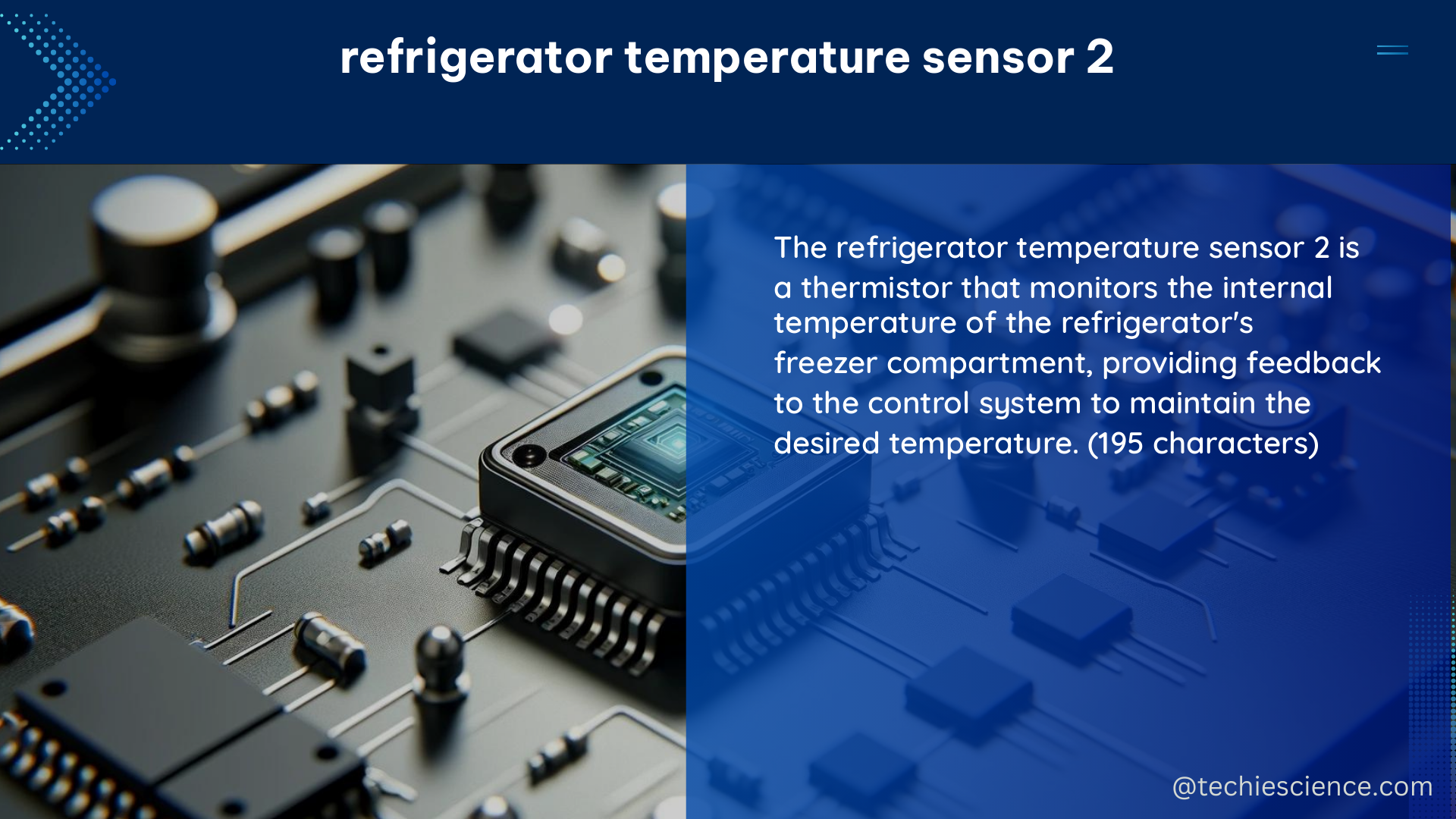The refrigerator temperature sensor 2 is a critical component in maintaining the optimal temperature within a refrigerator. It is responsible for accurately measuring the internal temperature and relaying this information to the refrigerator’s control board, which then adjusts the compressor and fan speeds accordingly to ensure the desired temperature is maintained.
Understanding the Resistance Value of Refrigerator Temperature Sensor 2
One of the most important aspects of the refrigerator temperature sensor 2 is its resistance value, which can be measured using a multimeter. According to industry experts, a multimeter can be used to test the temperature sensor by measuring its resistance. If the resistance is above or below the required level, or if there is no reading at all, it indicates a fault with the sensor, and it may need to be replaced.
The typical resistance range for a refrigerator temperature sensor 2 is between 1,000 and 10,000 ohms, with a temperature range of -40°C to 100°C. The sensor may also have a tolerance of ±5%, meaning the actual resistance value can deviate from the stated value by up to 5% without affecting its performance.
| Resistance Range | Temperature Range | Tolerance |
|---|---|---|
| 1,000 – 10,000 Ω | -40°C to 100°C | ±5% |
It’s important to note that the specific resistance and temperature ranges can vary depending on the make and model of the refrigerator, so it’s always best to refer to the manufacturer’s specifications when testing or replacing the sensor.
Additional Measurable Values of Refrigerator Temperature Sensor 2

In addition to resistance, the refrigerator temperature sensor 2 may also have other measurable values that are important to consider:
- Voltage Rating: The sensor may have a voltage rating, indicating the maximum voltage that can be applied to it without causing damage.
- Current Rating: The sensor may have a current rating, indicating the maximum current that can flow through it without causing damage.
Knowing these values can help ensure the sensor is operated within its safe limits and prevent any potential damage or malfunctions.
Accurate Measurement and Logging of Refrigerator Temperature
When testing the refrigerator temperature sensor 2, it is crucial to take accurate measurements and record the results. This can help identify any issues with the sensor and determine whether it needs to be replaced.
One tool that can be used to log temperature data in refrigerators is the Fridge-tag 2 L refrigerator temperature logger. This device can be used to log all measured temperatures and time data according to a predefined logging interval, providing a comprehensive record of the refrigerator’s temperature history.
The Fridge-tag 2 L can also generate a secure PDF/A report with all relevant temperature data presented in a clear and easily understandable manner, making it a valuable tool for monitoring and maintaining refrigerator temperature.
Troubleshooting and Replacing the Refrigerator Temperature Sensor 2
If the resistance value of the refrigerator temperature sensor 2 is found to be outside the recommended range, or if the sensor is not functioning correctly, it may need to be replaced. When replacing the sensor, it’s important to ensure that the new sensor is compatible with the refrigerator model and has the same technical specifications as the original.
To replace the refrigerator temperature sensor 2, follow these general steps:
- Unplug the refrigerator and locate the sensor, which is typically located near the evaporator coil or behind the control panel.
- Disconnect the sensor from the control board or wiring harness.
- Remove the sensor from its mounting location.
- Install the new sensor, ensuring it is securely in place and properly connected to the control board or wiring harness.
- Restore power to the refrigerator and test the new sensor to ensure it is functioning correctly.
It’s important to note that the specific steps for replacing the refrigerator temperature sensor 2 may vary depending on the make and model of the refrigerator, so it’s always best to refer to the manufacturer’s instructions or consult a professional technician if you’re unsure.
Conclusion
The refrigerator temperature sensor 2 is a critical component in maintaining the optimal temperature within a refrigerator. Understanding its resistance value, voltage and current ratings, and the importance of accurate measurement and logging can help ensure your refrigerator is operating at peak efficiency and preventing food spoilage.
By following the guidelines and best practices outlined in this comprehensive guide, you can effectively troubleshoot and replace the refrigerator temperature sensor 2 as needed, ensuring your refrigerator continues to function at its best.
References:
- How to Use a Multimeter to Test the Fridge Temperature Sensor on Your Fridge Freezer. (2022, August 12). Retrieved from https://www.youtube.com/watch?v=uIJ8DbMX3gg
- Refrigerator temperature logger solution | Fridge-tag 2 L – Berlinger. (n.d.). Retrieved from https://www.berlinger.com/cold-chain-management/refrigerator-temperature-logger-solution-1
- Effect of thermal ballast loading on temperature stability of domestic refrigerators and freezers. (2021, January 1). Retrieved from https://www.ncbi.nlm.nih.gov/pmc/articles/PMC7343171/

The lambdageeks.com Core SME Team is a group of experienced subject matter experts from diverse scientific and technical fields including Physics, Chemistry, Technology,Electronics & Electrical Engineering, Automotive, Mechanical Engineering. Our team collaborates to create high-quality, well-researched articles on a wide range of science and technology topics for the lambdageeks.com website.
All Our Senior SME are having more than 7 Years of experience in the respective fields . They are either Working Industry Professionals or assocaited With different Universities. Refer Our Authors Page to get to know About our Core SMEs.